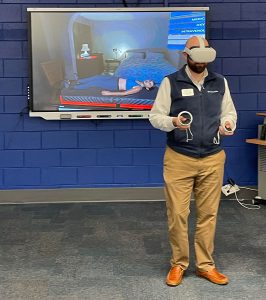
When the pandemic made it impossible to bring students to Lenoir Community College, Wesley Clark began looking for other ways to teach them.
“While we were working from home, I got out there and started doing some research and came across VRpatients,” says Clark, who is the Assistant Director of Emergency Medical Science at Lenoir Community College.
“It took me almost two years to get it approved and get funding for it, but we ultimately did. It basically comes down to the younger demographic that we work with today grew up gaming and VR is a way to get them engaged.”
Clark says to convince administrators, he also used the fact that he thinks VR is what is next for testing at the national level and using VRpatients would help prepare students for their future.
“The future is in VR and I’m convinced about that, so that’s kind of wrapped around the multiple layers of decisions and the ability to receive funds.”
Introduce VR Early in Training
Students at Lenoir Community College have been using VRpatients since the beginning of 2022 and Clark says he likes what he sees so far.
“In the VR world, we can teach them probably the most important component of EMS which is the ability to assess and treat a patient correctly,” Clark explains. “It’s as close to realism as you can get without having to have a manikin or live person and it gives the student the experience of assessing and treating patients.”
The majority of the usage at the school has been near the beginning of a student’s training in EMS.
“We start our students in VR then we move them to live scenarios with live patients and manikins in simulation. We start with VR first and let them get used to the tasks they need to do. They’re not physically doing them, but they understand the process and they once they understand the process, then they can go into actual simulations with manikins and live people.”
Through practicing in the VRpatients environment, Clark says his students are already getting comfortable with assessing patients, saving Clark and other instructors time.
“Hopefully they’ve learned the lesson in VR and they’ve got their systematic approach down so I don’t have to repeat that when I get into live simulations.”
The college has eight pairs of VR headsets so multiple students can train at once.
“I can have up to eight people in goggles and have them all doing something different and they can all be engaged. [In a non-VR environment,] If I have a group of six people and only three or four of them are working a simulation, I have two or three people doing nothing and they’re not engaged. If students are not engaged, they’re not learning.”

Clinical Case Scenarios That Come Included or Build Your Own
Clark says he has not relied entirely on the scenarios and situations that come with the VRpatients software and is already working to rapidly expand the library of cases by utilizing the capabilities of the VRpatients platform.
“You don’t always want to use what somebody else has built. Sometimes you want to build your own customized cases. We are all going to teach similarly but we’re not all going to teach identically,” he explains. “With VRpatients, you have that ability to change the clinical cases and I don’t think anybody else gives you the ability to get into the back end and change things like VRpatients.”
He says the team from VRpatients has been helpful with this and with any other issues that have come up.
“VRpatients has probably the best customer service practices of anybody. I’ve never gone lacking if I’ve needed something.”
VR Technology is Continuously Improving
Clark says one of his favorite things about VRpatients is the fact the students have the ability to interact with “patients” and ask them questions.
“The ability to talk to a patient is a little rudimentary right now because you have to go up and hit a question and then the patient will answer, so you’re not physically asking the patient question,” he says. “But you do have to have in your mind what to ask and go up and select that question.”
VRpatients gets most upgrade ideas from existing customers and Clark has spent time with VRpatients developers making suggestions for future enhancements, including natural voice recognition.
“We know there are things that are coming that will make it better and technology is going to get better over time.”
If you’re ready to see how VRpatients can help you in your training programs, request a demo.
